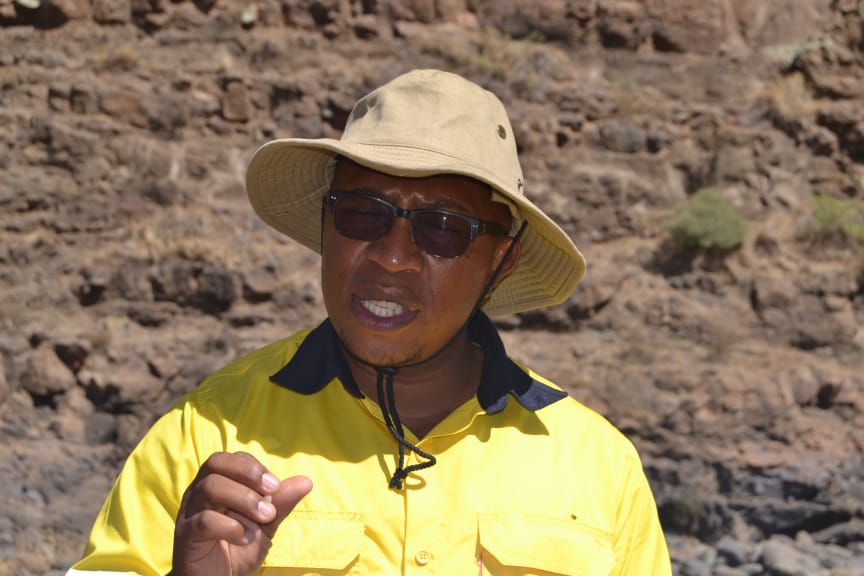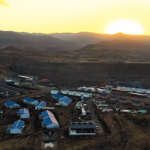Ntsoaki Motaung
All five rivers expected to supply the Polihali Dam with water are currently dry, a factor that is likely to pose a threat to the Polihali dam construction.
The dam is the Phase II part of the Lesotho Highlands Water Project implemented by the Lesotho Highlands Development Authority (LHDA).
Mokhotlong, Moremoholo, Sehonghong, Senqu and Khubeli Rivers will be the sources of the dam water, and at present all the five Rivers are dry, which will result in a pause in the construction of the dam whose wall is to be constructed across the Khubelu River.
As long as the situation does not change and we no longer get water from digging in the sand, we will be forced to pause with the construction works as they require lots of water. Already the situation is so dire that we have been quarrelling over water sources with nearby communities, who also do not have water for both human and animal consumption, The LHDA Branch Manager, Gerard Mokone said.
Currently taking place at Polihali is the advanced infrastructures that are the plenary works before the main construction of the dam. The works are expected to be completed by 2021, collect water towards the end of 2023, and then commence the dam building which is expected to be complete by 2026, along with the dam length is construction of camps and villages. Villagers will be relocated, while machinery will also be mounted at various points, Mokone explained.
He further pointed out that road constructions such as the Polihali North-East Road (PNEAR) from Mapholaneng to Polihali are amongst works that are already in progress for advance infrastructure for Phase II of the project.
He said the 16km long dual carriage tarred road costs M235.5million, and its construction contract was awarded to a joint venture of Lesotho and South African companies in November 2018, and it is expected to be complete by March 2021.
The second road is the Polihali North East Access Road from Ha Seshote along the A8, to Polihali. The 56kmlong dual carriage tarred road construction work has been split into two, with activities commencing from both ends. The contracts for this road were awarded in July 2019 at a total value of M1150.4 million, and it is estimated that this road will be complete by June 2021.
M488.5 million is for the West end, while M661.9 million is for the East end. Along with Phase II of the project, there are also constructions of Bulk power and Telecommunications infrastructures, Project Housing, Diversion Tunnel, and Major Bridges, Mokone said.
He added that the main works of the construction is the 163.5m high Polihali Dam Concrete Face Rock fill Dam type, and the 38km long transfer tunnel from Polihali to Katse.
Both works are expected to commence in the 3rd Quarter of 2020 and be complete by the end of year 2026. Polihali dam is expected to be the biggest Dam of the project in which many Basotho will benefit in terms of infrastructure and economically. However, the project is going to affect more people. Villages will be relocated, while government facilities like Lesotho Correctional Services, Water and Sewerage Company WASCO installations and some Schools will also be affected, he explained.
Mokone said consulting with communities which may be affected by phase II is a critical component of the projects preparation phase.
The LHDA has embarked on an extensive public consultation programme, using meetings and public gatherings as key vehicles to reach the public, both to inform the communities and to create a platform for dialogue, to understand better their views and concerns of the affected communities. The consultations and conversations with affected communities have been genuine, cooperative and honest. All in all 47 villages have been reached with 4382 people having attended the meetings and public gatherings. Mokone indicated.
Besides the already existing situation where people and animals struggle to get water, Phase II of the LHWP at Polihali works will be negatively affected. There are plans to bring to table the governments of the two countries, Lesotho and South Africa to table talks on the way forward on dealing with the situation, he revealed.
The agreement to proceed with the detailed feasibility study of Phase II was signed by the Governments of Lesotho and South Africa at Mohale on September 22, 2005, followed by the signing of the agreement to implement the phase in Maseru on August 11 2011.
As a result of Phase II of the project, South Africa will be guaranteed reliable and cost effective water supply by 2022, to meet the demands of the Gauteng region.
Phase II will increase the volume of Water to be transferred from the Katse Dam to South Africa from 780 million cubic meters to more than 1260 million cubic meters per annum, as well as increased electricity independence for Lesotho. The hydro electricity generated in Phase II is a further step in the process of securing an independent electricity source to meet Lesotho’s electricity requirements and will ensure consistent peak power supply.
Summary
- As long as the situation does not change and we no longer get water from digging in the sand, we will be forced to pause with the construction works as they require lots of water.
- The works are expected to be completed by 2021, collect water towards the end of 2023, and then commence the dam building which is expected to be complete by 2026, along with the dam length is construction of camps and villages.
- The LHDA has embarked on an extensive public consultation programme, using meetings and public gatherings as key vehicles to reach the public, both to inform the communities and to create a platform for dialogue, to understand better their views and concerns of the affected communities.

Your Trusted Source for News and Insights in Lesotho!
At Newsday Media, we are passionate about delivering accurate, timely, and engaging news and multimedia content to our diverse audience. Founded with the vision of revolutionizing the media landscape in Lesotho, we have grown into a leading hybrid media company that blends traditional journalism with innovative digital platforms.







